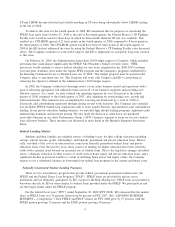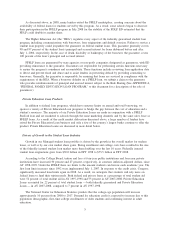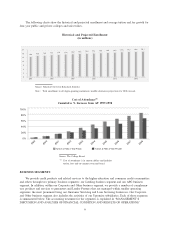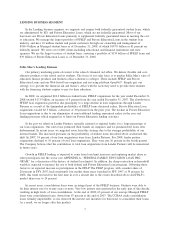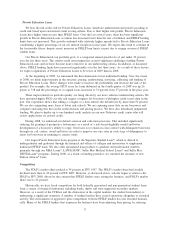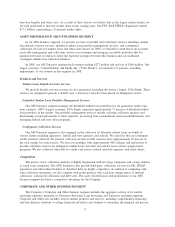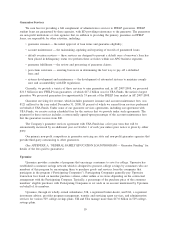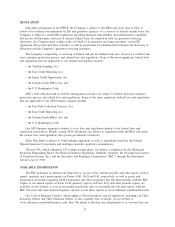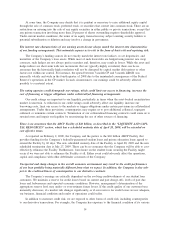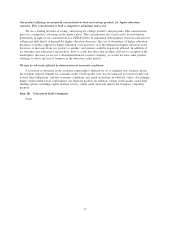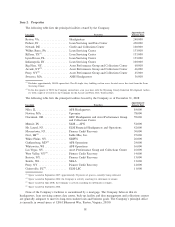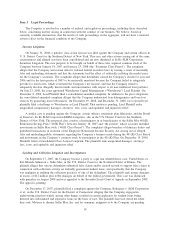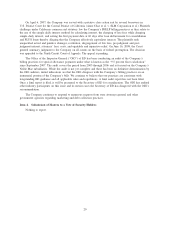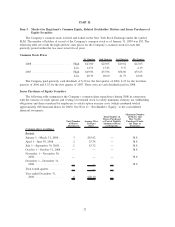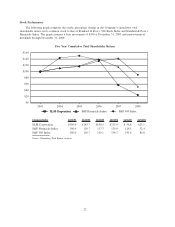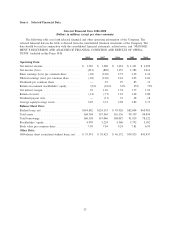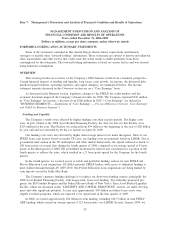Sallie Mae 2008 Annual Report Download - page 15
Download and view the complete annual report
Please find page 15 of the 2008 Sallie Mae annual report below. You can navigate through the pages in the report by either clicking on the pages listed below, or by using the keyword search tool below to find specific information within the annual report.At some time, the Company may decide that it is prudent or necessary to raise additional equity capital
through the sale of common stock, preferred stock, or securities that convert into common stock. There are no
restrictions on entering into the sale of any equity securities in either public or private transactions, except that
any private transaction involving more than 20 percent of shares outstanding requires shareholder approval.
Under current market conditions, the terms of an equity transaction may subject existing security holders to
potential subordination or dilution and may involve a change in governance.
The interest rate characteristics of our earning assets do not always match the interest rate characteristics
of our funding arrangements. This mismatch exposes us to risk in the form of basis risk and repricing risk.
The Company’s funding sources do not exactly match the interest rate indices, re-set frequencies, and
maturities of the Company’s loan assets. While most of such basis risks are hedged using interest rate swap
contracts, such hedges are not always perfect matches and, therefore, may result in losses. While the asset and
hedge indices are short-term with rate movements that are typically highly correlated, there can be no
assurance that the historically high correlation will not be disrupted by capital market dislocations or other
factors not within our control. For instance, the spread between 3-month CP and 3-month LIBOR was
unusually volatile and wide in the fourth quarter of 2008 due to the unintended consequences of the Federal
Reserve’s operations in the CP market. In such circumstances, our earnings could be adversely affected,
possibly to a material extent.
The rating agencies could downgrade our ratings, which could limit our access to financing, increase the
cost of financing or trigger obligations under collateralized financing arrangements.
Our credit ratings are important to our liquidity, particularly in times when the asset-backed securitization
market is uncertain. A reduction in our credit ratings could adversely affect our liquidity, increase our
borrowing costs, limit our access to the markets or trigger obligations under certain provisions in collateralized
arrangements. Under these provisions, counterparties may require us to post additional collateral, segregate
collateral or terminate certain contracts. Termination of our collateralized financing contracts could cause us to
sustain losses and impair our liquidity by necessitating the use of other sources of financing.
There is no assurance that the ABCP Facility of $26 billion, as described in the “LIQUIDITY AND CAPI-
TAL RESOURCES” section, which has a scheduled maturity date of April 28, 2009, will be extended on
cost effective terms.
As reported on February 2, 2009, the Company and the parties to the $26 billion ABCP Facility that
provides funding for the Company’s federally-guaranteed student loans and private education loans agreed to
extend the Facility by 60 days. The new scheduled maturity date of the Facility is April 28, 2009 and the new
scheduled termination date is July 27, 2009. There can be no assurance that the Company will be able to cost-
effectively refinance the Facility. Furthermore, foreclosure on the student loans securing the Facility might
occur if we were not able to refinance the Facility at all. Either event could adversely affect the operations,
capital and compliance with other debt/lender covenants of the Company.
Unexpected and sharp changes in the overall economic environment may result in the credit performance
of our loan portfolio being materially different from what we expect. In addition, the Company is also sub-
ject to the creditworthiness of counterparties to our derivative contracts.
The Company’s earnings are critically dependent on the evolving creditworthiness of our student loan
customers. We maintain a reserve for credit losses based on current and past charge-offs, levels of past due
loans and forbearances and expected economic conditions. However, management’s determination of the
appropriate reserve level may under- or over-estimate future losses. If the credit quality of our customer base
materially decreases, if a market risk changes significantly, or if our reserves for credit losses are not adequate,
our business, financial condition and results of operations could suffer.
In addition to customer credit risk, we are exposed to other forms of credit risk, including counterparties
to our derivative transactions. For example, the Company has exposure to the financial condition of its various
14


